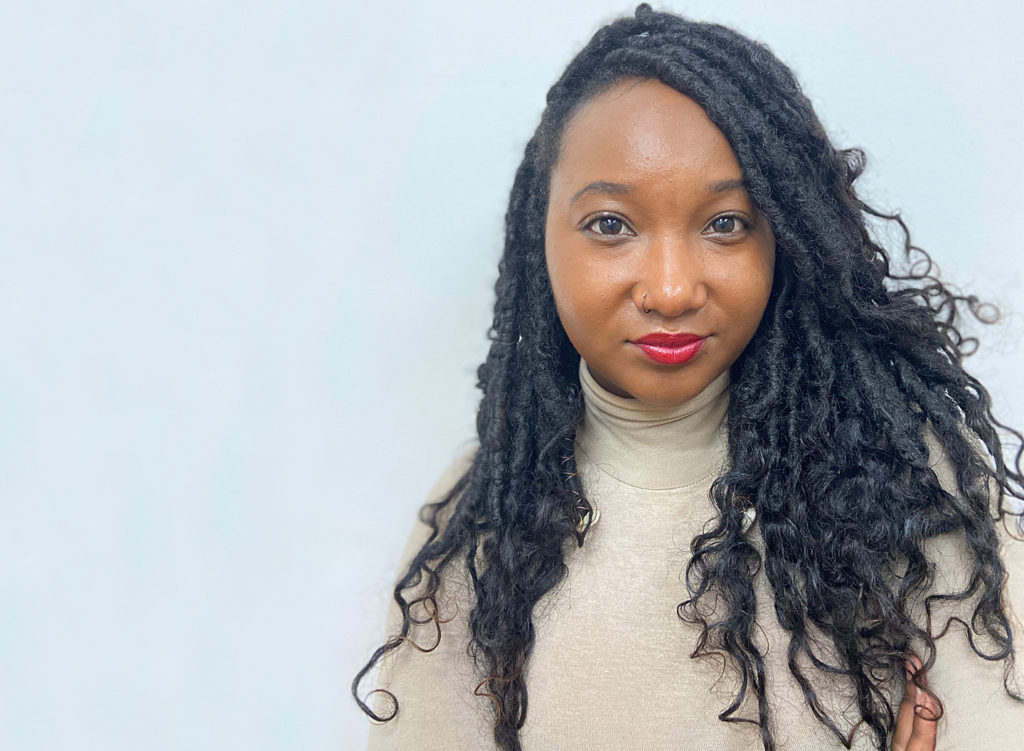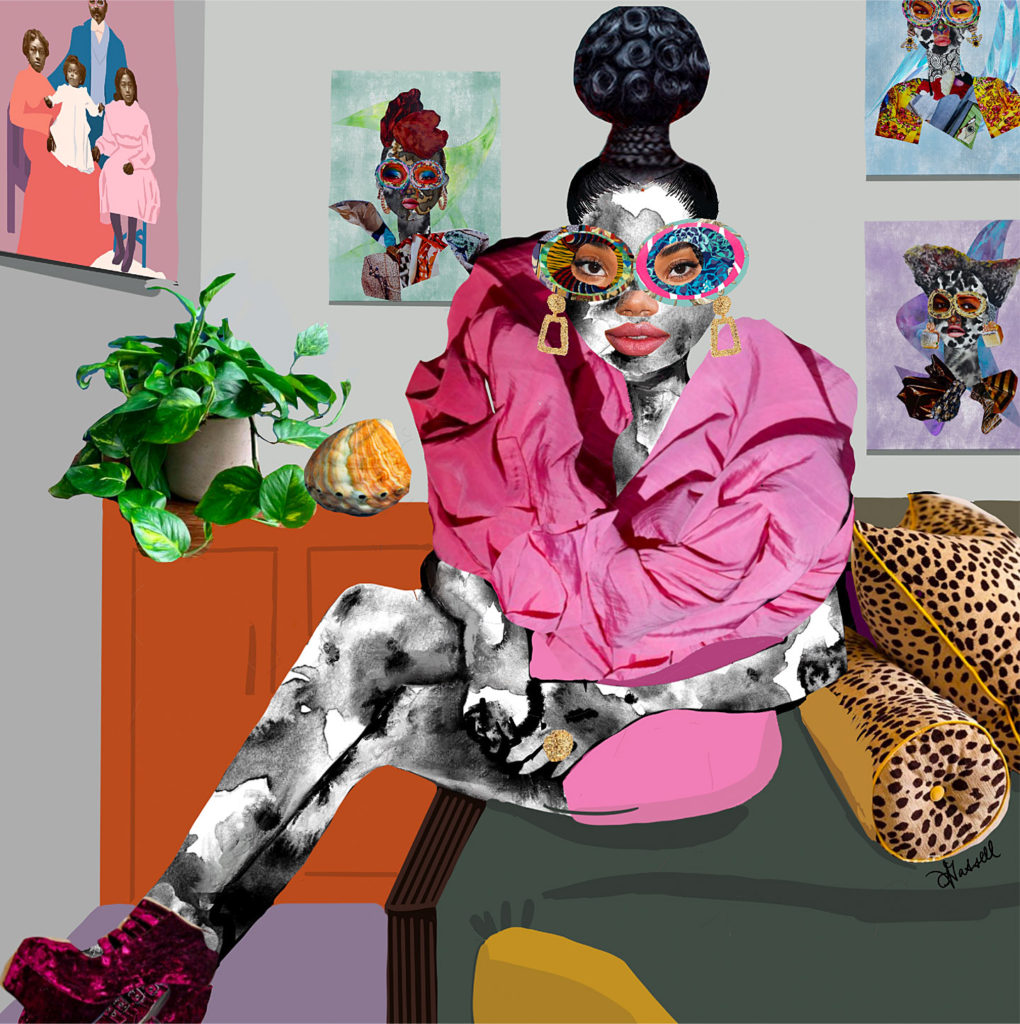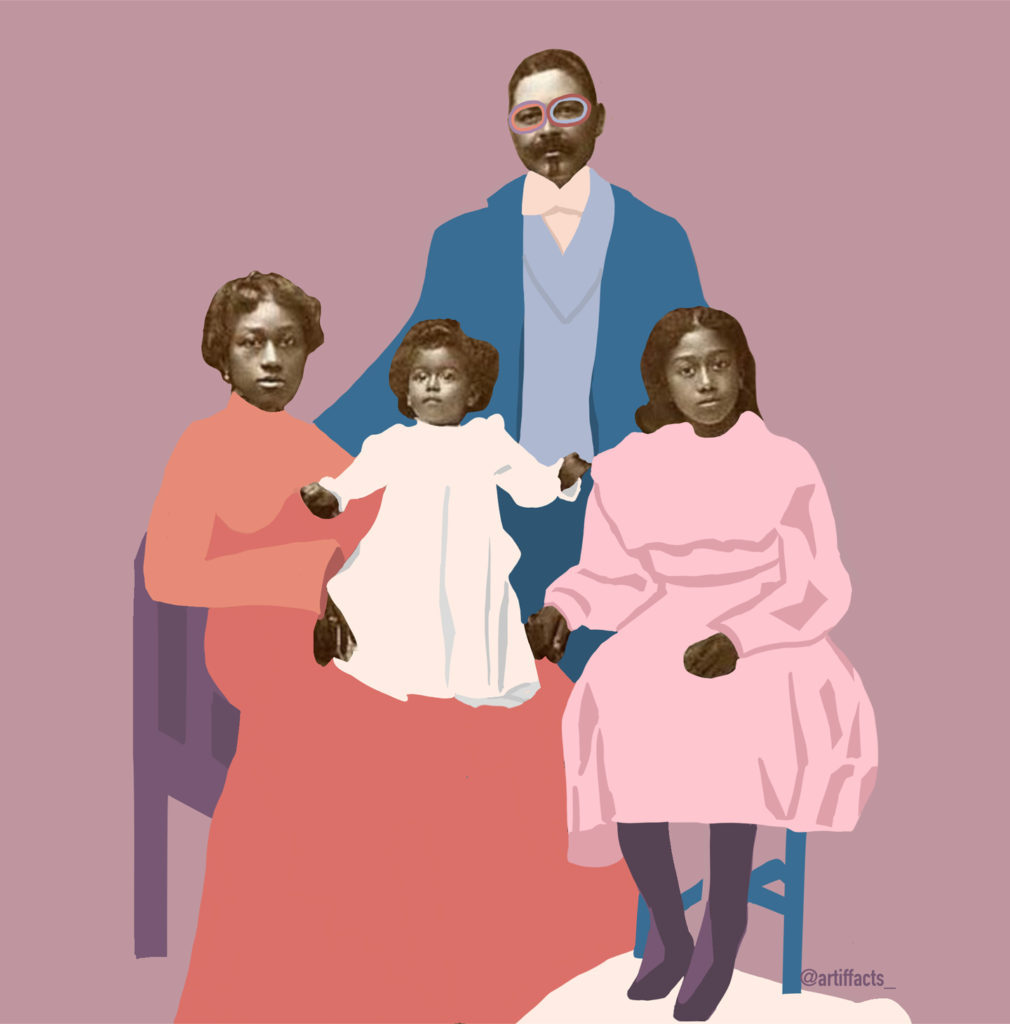A conversation between Marsha Pearce and Gherdai Hassell

Marsha Pearce: Hello Gherdai, it’s a pleasure to connect with you. Where are you in this strange world? Are you in China? And how are you doing?
Gherdai Hassell: Very pleased to meet you Marsha. My time is split between the U.K., Bermuda and China. I’m a Master’s student at the China Academy of Art studying contemporary art. Currently, I’m based in the U.K. I left China right in the heart of the outbreak in Wuhan. I was two provinces away from Wuhan. I’ve been here in the U.K. since January because of the pandemic. We don’t have an answer about returning to China yet, therefore I’m here indefinitely, until further notice.
We live in a world in which the white male gaze is privileged; a global context in which we are not only facing the novel coronavirus pandemic but also what UN Women has called “a shadow pandemic of violence against women.” In contrast, your collage work featuring Black female figures, gives emphasis to eyes as a way of foregrounding a Black female gaze. The eyes are not only enlarged, you also build them in layers, which you have described as veils or safe spaces for holding the eyes. You seem to be holding space to see, perceive, feel, think, experience, to be. Please tell me about your Alibii collage series. Why that title? And how do you understand the works and their address of perception, veiling and safety in these times?
I have been thinking heavily about how Black women are the most unprotected group. At a time of Black Lives Matter movement, Black women have had violence occurring against them at an all-time high. I began making the alibii’s when I was in China. It was a therapeutic exercise against the alienation and overbearing otherness I experienced while living in the city of Guiyang. Living in that city felt very isolating. It was hard for me as one of the few Black people in the city. I would step outside of my apartment and people would stare, point, take photos of me, and follow me. I grew a heightened awareness of myself as a Black person. I’ve always been connected to my Blackness but never felt so Black, until I moved to China. The Eurocentric gaze has become globalized. Global media gives a false narrative of Black people presented from a Eurocentric, male gaze of privilege. Groups of people believe certain stereotypes of Black people before even encountering a Black person. The alibiis emerged as a way for me to deal with the unwanted attention I was experiencing. The layering became the distancing between myself and the eyes of others.
I also, at this time, began experimenting with Chinese calligraphy inks on different kinds of watercolour and traditional Chinese rice paper. I used the materials of the culture, which I was in, and added a contemporary twist to the ways in which they were used. Because my skin in China was always a point of inquiry for Chinese people, I figured it could be awesome to investigate, within myself, what it means to walk in the world in a Black body. I loved the way the inks allowed me to explore what it means to have Black skin. I employed the inks to create skin which acted like a membrane between the outside and inner worlds. This in turn created humanoid figures, which claimed their own characterization. I chose to entitle them alibii, because “to alibi” means to cover, or to shield or protect. I turned to making these to make sense of what I was experiencing in the outside world. I added the extra “i”, on the end of the word to give reference to the double consciousness that I as a Black person have to experience. The “i” that other people see me as, and the “i” that I am. The “ii” also points to my own gaze – the Black female gaze – and highlights that only my viewpoint is important when determining self-worth. The layering acts as security and comfort from the outside world. The shadow pandemic of violence against women has highlighted how safe spaces are needed for us. We need to hold spaces for reverence. Particularly for Black women, as the most unprotected group in the world. As Malcom X said: “The most disrespected woman in America is the Black woman.” The collages are representations of confident, self-actualizing women. The alibiis have evolved from providing veiling for Black women from an outside view, to providing space because we deserve it.

You recently launched the Artiffacts Project. You have been exploring archival photographs of people of the African Diaspora, examining your ancestry, thinking about roots and childhood memories. And you’re using these experiences to create new paintings. I’d love to hear more about this project. How are you considering notions of memory, time, family and selfhood? What might this project offer to current conversations about public monuments?
I’m from the Island of Bermuda. Bermuda was involved in the slave trade. The Artiffacts project began when I found my family tree. I had never come across my family heritage. Having access to my family tree inspired me to look more into the Bermuda Archives. So, I went there looking for more information about my family. Unfortunately, I was unable to find more information, however, I did discover slave registers and some vintage photographs of Afro Bermudians. I was fascinated by the faces of the people. In Bermuda, there’s a disconnect between living descendants of slaves and what people experienced. We see the effects of slavery everywhere on island, from the class system, the wealth disparity and racist, white supremacy built into the institutions of the country. Much of the truth about the history of Bermuda’s hand in slavery has been covered up. So much so, that slavery has been referred to as “benign.” We don’t learn about much of anything related to this Bermudian history in the education system. So, there’s a gap in understanding. But now I think people are waking up to the reality of why things are the way they are. The Artiffacts project is about piecing together histories of the past, present and future.
I’ve been thinking about how recalling the lives of the people who endured such horrors, can erect a monument of memory to pay homage and honour those who have otherwise been forgotten or intentionally left out of history. We look at history as a view of the past, but its consequences are occurring now. How we correct our past errors determines our future realities. This inspired the thought for me that the past, present and future are occurring simultaneously. I’m now working on this project to develop the grounds for my thesis work. Seeking to reclaim my Bermudian heritage and Caribbean ancestry, the archive becomes the portal to explore relationships between the following things: archive and memory, archive and public information, archive and traces, archive and displacement, archive and identity, archive and time.

In June you shared the first episode of your new podcast The Art Affects. Your podcast offers insight to your personal journey as an artist and shares conversations with other Bermudian contemporary artists. Why was it important for you to start this kind of work now? What are the aims of your podcast?
I’ve wanted to do this project for a long time, and I’ve continuously put it off. Shelter in place was stressful and isolating. I felt like during quarantine, we as people and artists needed more opportunities for connectivity, so I felt moved to begin. I constantly research other artists and their work. Art inspires more art, so I thought it would be awesome to speak directly with the artists and learn about their stories. I wanted to begin at home, because artists in Bermuda are talented! Because I don’t live on island, I’m always looking for opportunities to keep the connection to my home. I’m starting conversations with Bermudian artists, however, as the podcast grows, I’ll be in conversation with Black artists worldwide. The podcast is a celebration of art by artists of the African diaspora . The goal is to highlight Black creativity, to amplify Black artists’ voices and underscore their ideas. Art Affects provides a platform for other artists to talk about their work, to offer a space for artists to be introduced to other artists, and to connect Black people with the creativity that runs through our veins. I’d like for the podcast to inspire people to reach their dreams.
Your thoughts on how quarantine prompted you to think about connectivity for artists really resonates with me – this was one of the motivators for me (the idea of community) when I conceived this Quarantine and Art series. I want to talk about your work for the 2020 Bermuda Biennial. You have a piece in the exhibition titled Interactions Bermuda. The female figures in the work are physically apart but their auras touch. There is an emanation surrounding each body that ‘interacts.’ Although the notion of the aura is not new, this work feels particularly prescient in our age of social distancing. How is our present context shaping your ideas about interactions with others and connecting to self?
It’s so funny how the Biennial submission is so timely. I started working on it last year, but it was installed in February of this year. Of course, while I was working on the installation, I had no idea that social distancing would become a reality for us across the world. Art always reflects life. When making the work I was thinking about how we interact with each another as humans. And, how the auras we emanate can determine our physical interactions with other people. Now, the ways in which we can connect during shelter in place have radically shifted our lives on a global level. For me during this time, quarantine inspired me to slow down – to tap into myself and my body more. To listen to my inner voice. And to be more international about what vibes or energies I’m sharing with the world. I think very much that our inner experiences and lives dictate our physical experiences. It’s all about energy.
Stay connected with Gherdai Hassell:
Instagram: @hassell_free @artiffacts_ and @theartaffects
Website: gherdaihassell.com

Comments are closed, but trackbacks and pingbacks are open.